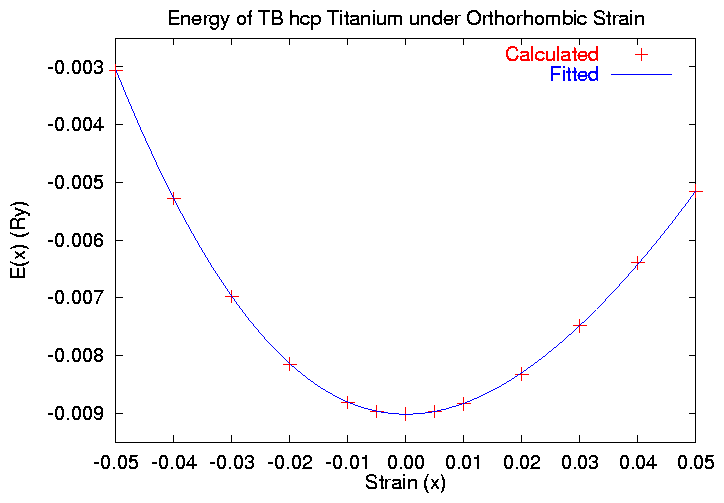
Last Modified 17 December 1999
On the previous page we discovered that in order to determine C11-C12 in a hcp lattice we needed to strain the crystal so that the primitive vectors become
| a1 | = ( | ½ a (1+e1), | - ½ 3½ a (1+e2), | 0) | |
| a2 | = ( | ½ a (1+e1), | - ½ 3½ a (1+e2), | 0) | . (1) |
| a3 | = ( | 0 , | 0 , | c ) |
| e1 | = | [(1+x)/(1-x)]½ - 1 | |
| e2 | = | [(1-x)/(1+x)]½ - 1 | (2) |
| B1 | = | (1/3 - u) a1 + (2/3 + u) a2 + 1/4 a3 | = | ( ½ (1+e1) a , ½ 3-½ (1+e2) (1+2u), ¼ c ) | |
| B2 | = | 2/3 a1 + 1/3 a2 + 3/4 a3 | = | ( ½ (1+e1) a , -½ 3-½ (1+e2) (1+2u), ¾ c ) | , (3) |
We need to follow the same basic procedure as in the EOS calculation:
E(x) = E0 + V0 (C11-C12) x2 + O[x3] . (4)
To run the calculation, we need the spacegroup file work/c11-c12/spcgp1.63 . This is not quite the same as the corresponding space group file for the B33 lattice because we are using a different set of primitive vectors. We also need a k-point mesh. Again, as for the previous calculations in this section, we can save a lot of time by determining the k-point mesh once and for all. We do this by the same means as for the true hcp lattice, only using the lower symmetry space group file for Cmcm, work/c11-c12/spcgp1.63. The resulting k-point mesh contains 637 points and is stored in work/c11-c12/kmesh.63 .
The remaining procedure pretty much follows the work in finding the EOS. We need
The examples follow the EOS work, so I won't go through them here. You can look in the directory work/c11-c12 for the results. In particular, look at the file work/c11-c12/skeng.0.0000 to see the limitations of this method.
Finally, we get the energy file work/c11-c12/c11-c12.eng , which looks like this:
-0.0500 0.007530876 220.088000 .123181890 -.003061492 -0.0400 0.006483847 220.088000 .124775419 -.005282802 -0.0300 0.005160538 220.088000 .126205172 -.006979316 -0.0200 0.003693353 220.088000 .127352993 -.008151138 -0.0100 0.002037456 220.088000 .128157175 -.008814712 -0.0050 0.001071564 220.088000 .128389330 -.008969137 0.0000 0.000000000 220.088000 .128472502 -.009018141 0.0050 -0.001159830 220.088000 .128384019 -.008972413 0.0100 -0.002337862 220.088000 .128120487 -.008839575 0.0200 -0.004609668 220.088000 .127145485 -.008322533 0.0300 -0.006843999 220.088000 .125709107 -.007487313 0.0400 -0.009060559 220.088000 .123926395 -.006397543 0.0500 -0.011319330 220.088000 .121940516 -.005153007
Using the fitting/plotting routine work/c11-c12/c11-c12fit.gnu we get:
$ gnuplot c11-c12fit.gnu Using vo = 220.088 eo = -0.009018141 Edit c11-c12fit.gnu if necessary Pressto continue [Delete fitting information. See work/c11-c12/fit.log for details C_{11}-C_{12} = 133.531675480411 GPa Press to quit

So in summary, in this section we found
C11 - C12 = 133.5 GPa
Go back to the theory.
Go back to the Example X home page.
Look at other examples.
Get other parameters from the Tight-binding periodic table.
Return to the static Reference Manual.